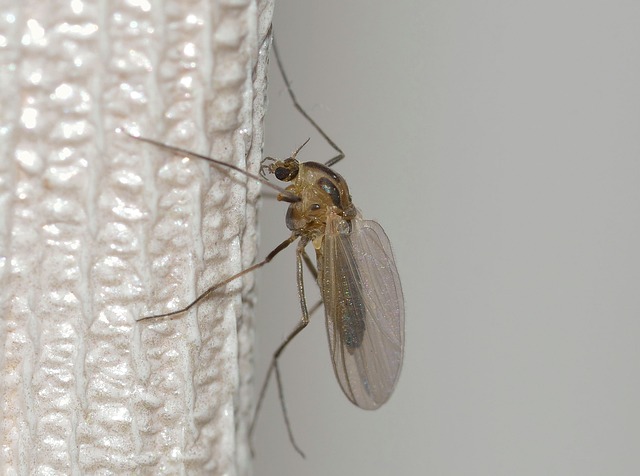Professional mosquito extermination requires a multi-faceted approach targeting mosquitoes' complex life cycles and habitats. This includes using adulticides, larvicides, and traps, with an integrated strategy involving regular maintenance and community involvement. Advances in methods like biological control and eco-friendly insecticides balance human health needs with environmental preservation. By combining quick fixes with long-term solutions—such as removing standing water, using protective netting, and applying repellents—professional services disrupt mosquito population growth effectively.
“Mosquitoes, despite their tiny size, pose a significant health threat worldwide. Understanding their behavior is crucial for effective mosquito control. This article explores comprehensive strategies to eliminate mosquito populations, from professional extermination techniques like targeted treatments and barrier sprays to sustainable methods that consider environmental impact.
We delve into the importance of knowledge about mosquito habits and present long-term solutions, emphasizing that proactive measures, such as source reduction and proper drainage, are key to a professional mosquito extermination approach.”
Understanding Mosquito Behavior: Key to Effective Extermination
Understanding mosquito behavior is a critical step in implementing effective professional mosquito extermination methods. Mosquitoes are highly adaptive and have complex life cycles, which can make them difficult to control. These insects go through four stages—egg, larva, pupa, and adult—and they prefer specific habitats at each stage. Adult mosquitoes seek out standing water for breeding, while larvae thrive in stagnant or slow-moving water bodies. By identifying these breeding sites, professionals can target their extermination efforts more precisely.
Knowledge of mosquito behavior also helps in choosing the right tools and tactics. For instance, adulticides, which are chemicals designed to kill adult mosquitoes, may be applied by spraying or ultra-low volume (ULV) equipment for better control. Larvicides, on the other hand, are used to eliminate larvae directly in breeding sites. Additionally, traps that attract and capture mosquitoes can be employed as a monitoring tool and to reduce overall population levels. Such an integrated approach, combined with regular maintenance and community involvement, can significantly reduce mosquito populations and create a more comfortable living environment for residents.
Professional Mosquito Control Methods and Their Applications
Professional mosquito control methods have evolved significantly, offering a range of effective solutions for eliminating mosquito populations in various settings. One of the most common and targeted approaches involves the use of insecticides, including synthetic and organic compounds specifically designed to combat mosquitoes. These chemicals are applied strategically in areas where mosquitoes breed and rest, such as standing water sources, vegetation, and indoor spaces. Professional exterminators employ advanced equipment and techniques for precise application, ensuring minimal environmental impact while maximally targeting mosquito habitats.
Another powerful tool in the arsenal of professional mosquito extermination is biological control. This method leverages natural predators and parasites to manage mosquito populations. For example, introducing specific bacteria or viruses can infect and reduce mosquito numbers without affecting other organisms. Additionally, the use of fish that feed on mosquito larvae, like Gambusia, is a popular eco-friendly solution for managing breeding sites in ponds and water bodies. These professional strategies are particularly valuable in urban areas, rural communities, and outdoor venues where conventional methods may have limited accessibility or environmental concerns.
Environmental Considerations for Sustainable Mosquito Elimination
When it comes to sustainable mosquito elimination, environmental considerations play a pivotal role in effective professional mosquito extermination strategies. It’s crucial to adopt methods that minimize ecological impact while targeting mosquito habitats and breeding grounds. Integrating natural predators like fish species known for feasting on mosquitoes’ larvae into affected water bodies can significantly curb their population. Additionally, removing stagnant water sources—a favorite breeding ground for mosquitoes—through proper drainage or water feature maintenance is essential.
Beyond biological control and habitat manipulation, professionals employ physical barriers and chemical treatments. Installing mosquito nets and screens in homes and public spaces reduces human-mosquito contact. Targeted applications of environmental-friendly insecticides and larvicides can also be utilized, focusing on areas where mosquitoes rest and breed. These strategies collectively contribute to a holistic approach to mosquito control that prioritizes both human health and the overall ecosystem balance.
Preventative Measures: Long-term Solutions for Mosquito Management
Mosquitoes are persistent pests, and eliminating them requires a multi-faceted approach. While quick fixes like insecticides offer temporary relief, long-term solutions involve preventative measures that target their breeding grounds and life cycles. One of the most effective strategies is to employ professional mosquito extermination services that specialize in identifying and treating specific areas where mosquitoes thrive. These professionals can assess properties, locate breeding sites, and implement tailored treatments to disrupt the mosquito population’s growth.
Implementing structural changes and maintaining a clean environment significantly contributes to mosquito control. This includes eliminating standing water—a crucial breeding ground for mosquitoes—by regularly emptying containers, fixing leaky pipes, and ensuring proper drainage. Additionally, using protective netting, screens, and insect repellents can create physical barriers against these insects. By combining these preventative measures with professional interventions, it’s possible to achieve lasting reduction in mosquito populations.
Eliminating mosquito populations requires a multifaceted approach, from understanding their behavior to employing sustainable methods. Professional mosquito extermination techniques, such as targeted applications of environmental-friendly pesticides and biological control, offer effective solutions. Additionally, adopting preventative measures like proper drainage systems and using insect repellents can significantly reduce mosquito habitats. By combining these strategies, we can create a robust mosquito management plan that protects public health without causing environmental harm.
